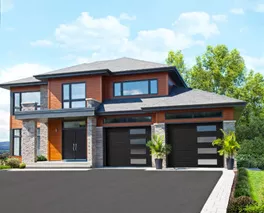
Whether you’re building a new home or renovating, one of your main concerns is going to be making sure that the colors all work together. A good color scheme makes your home look inviting and welcoming. So, how should you coordinate the colors?
Basic guidelines
The basic elements that determine the appearance of your home are exterior materials, accent colors, and accent details. These consist of:
- Exterior materials:
- Brick, stone, stucco, vinyl or pressed wood.
- The ways that these materials work together.
- Remember that the materials you use on your home’s exterior will set the overall tone.
- The colors chosen for window trim, entry doors, and garage doors.
- Decorative elements like soffits, cornices, railings, shutters, and any other architectural elements that work together to create the overall appearance of your home.
Today, colors are virtually limitless, so there really is something to suit every taste. The colors that you combine for the main exterior will carry over into the details, though, so make sure that you choose something you love, and also consider how much time you’re willing to spend on maintaining it all.
How your home looks compared with the rest of your neighborhood
When choosing exterior colors, consider not just your home itself, but the way it is going to fit in with the homes of your neighbors. Generally speaking, a Victorian style home, for example, is best painted in pastels with a few bursts of color. A modern home can be more colorful. Consider other aspects of the exterior as well – brick and stone are usually best complemented by neutral shades.
Take a look at your landscaping too. Colorful flowers can add a visual pop to a sedate home, and a lot of greenery can add warmth to a colonial home. The plants that you choose will complement the colors that you select for your exterior. You will also want to landscape according to which side of your home receives the most sun or shade.
Ultimately, you want to show off your home, but not to the point where it looks odd in comparison with others in your neighborhood. Keep in mind, too, that if you are living in a subdivision, there may be regulations in place as to the paint colors and landscaping materials that you will be permitted to use.
Creating a theme
Consider the architectural style of your home, and that of other homes in your area. Are bright colors typical? Are you restricted to using pastels? You want to fit in, so consider the elements you are using carefully. You want to create a look that is harmonious, yet individualistic.
Choosing the right shades can be as simple as looking at paint company websites. Take a look at various colors, and see how they’ll work together.
Don’t neglect your front door and garage door
Much of the time, the first thing people notice about your home is your front door, or your garage door. Choose a color that is compatible with the rest of the exterior, without dominating it. What this means is that if your exterior is an understated pastel, you can choose something more vibrant for the front door and the garage door. If you already have a pop of color in these two areas, then tone down any exterior areas that you are thinking about painting.
Usually, it is not a good idea to put too much emphasis on the garage door, especially if it is situated at the front of your home. Pale tones are best. If your garage door is already painted a vibrant color, you can tone it down by planting greenery in front, or perhaps adding a pergola.
Windows can also enhance your garage door, especially if they coordinate with the front door. Garaga’s Design Centre can help you to visualize how this will look and we will also be happy to give you a free quote.
Now that you know how to create a unique appearance for your front and garage door, contact us. We can help you to make the choice that is exactly right for your particular sense of style, with an eye toward your budget as well.

Add new comment